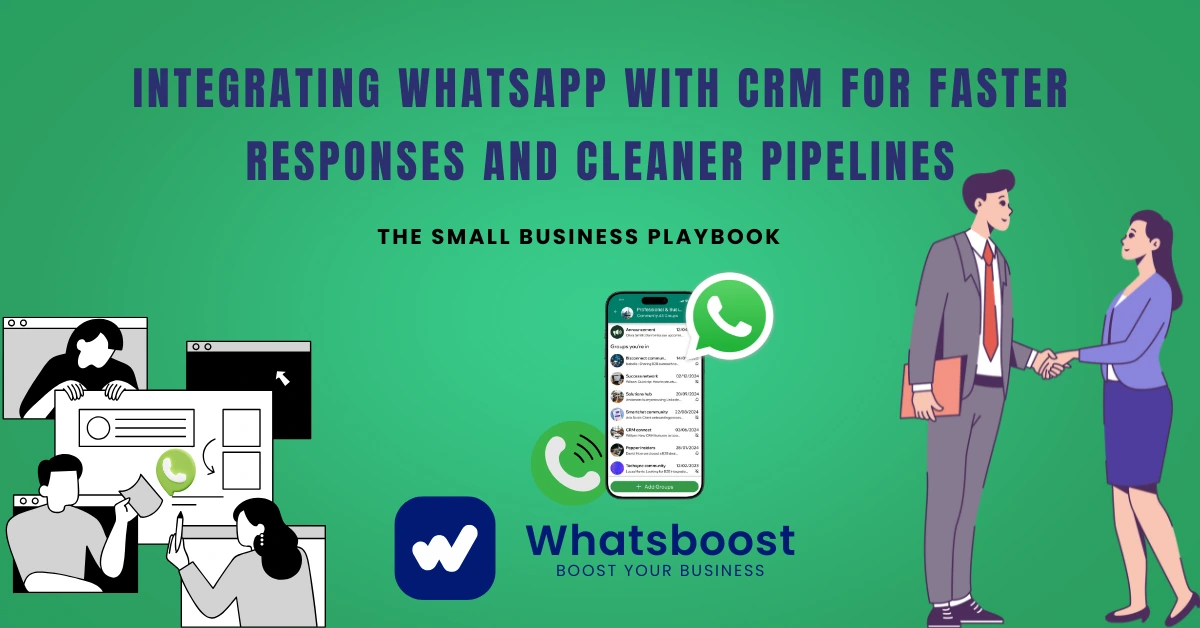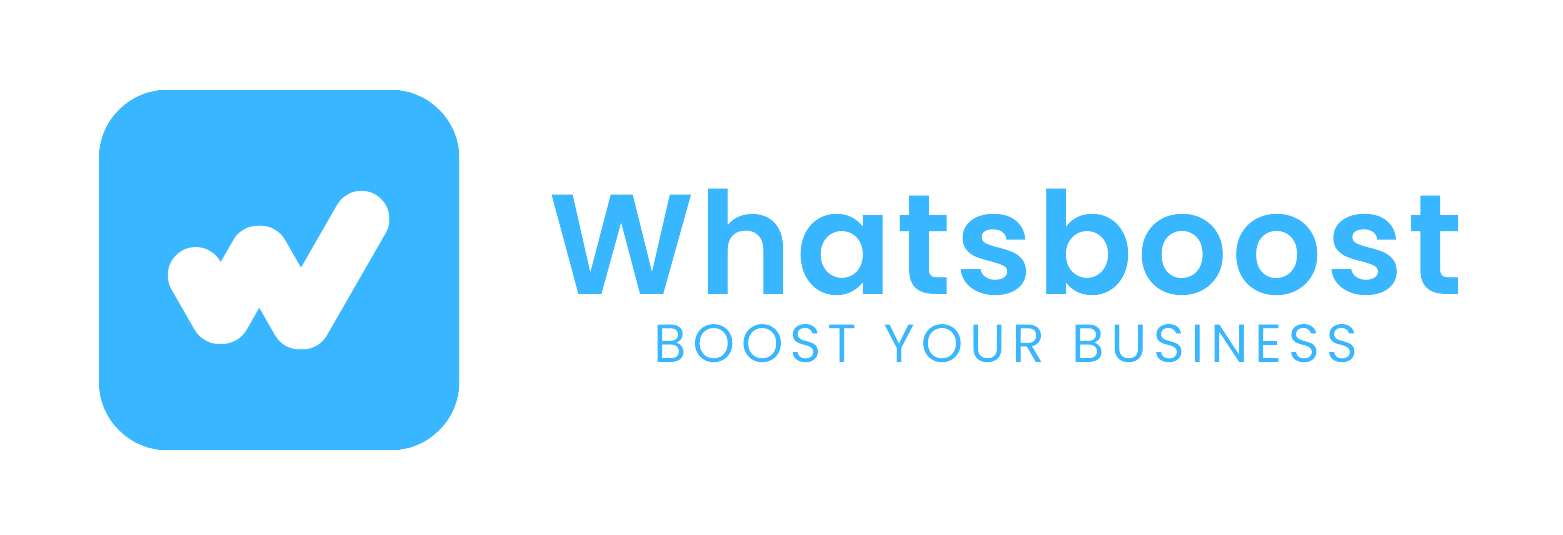
The Small Business Playbook: Integrating WhatsApp with CRM for Faster Responses and Cleaner Pipelines
Learn how WhatsApp CRM and pipelines can help small business owners streamline communication, speed up responses, and build cleaner, more organized sales pipelines. Discover how Whatsboost makes integration easy and efficient.
In today’s fast-moving digital world, small businesses face one big challenge — how to respond quickly to customers while keeping their sales organized. That’s where integrating WhatsApp with CRM becomes a game changer.
In this article, we’ll break down how WhatsApp CRM and pipelines can help small business owners manage leads, speed up responses, and create smoother customer journeys — and how tools like Whatsboost.in make it all easy, affordable, and scalable.
Why Small Businesses Need WhatsApp CRM Integration
WhatsApp is no longer just for personal chats. With over 2 billion users, it’s the most direct and preferred communication channel for customers.
At the same time, CRM (Customer Relationship Management) tools are the backbone of business organization — they store contacts, manage interactions, and track deals.
When you combine the two, you get a unified system that merges instant communication with structured sales tracking. The result?
Faster customer replies
Clean, automated pipelines
Improved data accuracy
And happier customers
This is exactly how WhatsApp CRM and pipelines help small business owners compete with larger players — without needing huge budgets or tech teams.
Understanding WhatsApp CRM and Pipelines for Small Business Owners
Before diving into the “how,” let’s understand what these tools really do.
1. WhatsApp for Business
WhatsApp Business allows companies to send texts, images, and files — but also to automate replies and manage conversations using tools like Whatsboost. This means every customer message can be tracked, tagged, and responded to instantly.
2. CRM Systems
A CRM centralizes all customer interactions — names, contact info, chat history, deal stages, and more. It ensures no lead is forgotten or lost in the shuffle.
When integrated together, WhatsApp and CRM create a smooth, two-way communication flow:
Every message automatically logs into the CRM.
Conversations are tagged and assigned to the right sales rep.
Follow-ups and reminders are triggered instantly.
This integration not only saves time but also ensures that your pipeline remains clean, updated, and data-rich.
The Benefits: Why Every Small Business Needs WhatsApp CRM Integration
Here’s how WhatsApp CRM and pipelines can help small business owners build speed, efficiency, and customer trust.
1. Faster Response Times
Customers expect near-instant replies — and delays can cost you sales.
Integrating WhatsApp into your CRM allows automatic message routing, pre-set replies, and lead assignment. Instead of switching between apps, your team can respond within minutes — directly from your CRM dashboard.
2. Cleaner Sales Pipelines
Forget juggling spreadsheets and chat screenshots. With integration, every WhatsApp message is automatically recorded under the correct lead or deal.
Old chats? Archived automatically.
New leads? Logged instantly.
Dead deals? Filtered out.
You’ll always have a clear, uncluttered pipeline that highlights high-value leads and next steps.
3. Improved Data Accuracy
Manual entry leads to typos, missed notes, and lost opportunities. With WhatsApp–CRM syncing, contact details, preferences, and chat history are automatically saved and updated — no extra work needed.
4. Streamlined Team Collaboration
Assign WhatsApp conversations to the right agent or department automatically. Sales teams, support reps, and managers can all view updates in real time — without stepping on each other’s toes.
5. Actionable Analytics
Once integrated, WhatsApp data flows into your CRM’s analytics dashboard. You can track:
Average response times
Lead conversion rates
Customer satisfaction levels
This data helps you spot performance bottlenecks and make smarter, faster decisions.
Step-by-Step: How to Integrate WhatsApp with CRM
You don’t need to be a tech expert to get started. Here’s a simplified version of the process most small businesses follow — or that Whatsboost can automate for you.
Step 1: Set Up WhatsApp Business
Create a verified WhatsApp Business account with a dedicated number for your business. Enable features like quick replies and labels.
Step 2: Choose a Compatible CRM
Use a CRM that supports WhatsApp integration — or better yet, connect WhatsApp through Whatsboost, which syncs with your favorite CRM tools.
Step 3: Map Your Data Flow
Decide how information should move between WhatsApp and the CRM.
For example:
A new WhatsApp message → creates a new lead in CRM.
A pipeline stage update → triggers a WhatsApp follow-up message.
Step 4: Test Automations
Before going live, simulate different customer interactions — from inquiries to purchases — to ensure messages sync correctly.
Step 5: Train Your Team
Teach your staff how to view WhatsApp messages from within the CRM and how to use automation responsibly.
Step 6: Secure Your Data
Always encrypt customer data, set access permissions, and review logs regularly to maintain privacy and compliance.
Best Practices: Getting the Most Out of WhatsApp + CRM Integration
To make sure your integration delivers real results, follow these proven practices:
1. Personalize Messages
Use CRM data to make WhatsApp messages feel human. Mention the customer’s name or refer to past purchases. This builds trust and keeps engagement high.
2. Automate Smartly
Set up automation rules for repetitive tasks — such as sending thank-you messages or reminders — while keeping critical interactions personal.
3. Keep Your Pipeline Organized
Use Whatsboost’s built-in filters and lead scoring to keep your pipeline clean. Archive inactive leads and focus on the ones most likely to convert.
4. Monitor KPIs
Track key metrics such as open rates, first response time, and customer satisfaction. This helps refine your process over time.
5. Respect Privacy
Always ask for customer consent before messaging and offer opt-outs. Transparency is key to maintaining your brand reputation.
Real-World Examples: How Small Businesses Win with WhatsApp CRM
Let’s look at how WhatsApp CRM integration transforms small businesses in different industries:
Example 1: Handmade Crafts Store
Before integration, messages were scattered across devices, leading to missed inquiries. After using Whatsboost to link WhatsApp with CRM, every message became a lead record. Response times dropped from hours to minutes — resulting in a 40% increase in sales conversions.
Example 2: Local Service Business
A plumbing company used WhatsApp CRM to manage emergency requests. Customer messages automatically generated CRM tickets, triggering alerts and dispatch workflows. The result? Faster response times, cleaner pipelines, and higher customer retention.
These cases show how WhatsApp CRM and pipelines help small business owners scale efficiency without needing big investments.
Common Challenges and How to Overcome Them
Even the best integrations have hurdles — but they’re easy to fix when you plan ahead.
1. Connectivity Issues
APIs can sometimes break. Use reliable hosting and add fallback options (like email notifications) through Whatsboost’s automation system.
2. Data Overload
Too many messages can clutter your CRM. Set filters to archive low-priority chats automatically.
3. Cost Concerns
Start with basic features and scale gradually. Whatsboost offers affordable automation plans designed for small businesses.
4. Team Adoption
Provide hands-on training and show your team how integration saves time. Once they see it in action, adoption skyrockets.
The Future of Small Business Communication
Integrating WhatsApp with CRM is more than just a tech upgrade — it’s a strategic advantage. It allows small businesses to:
Engage customers instantly
Keep pipelines organized
Make data-driven decisions
Scale without chaos
With tools like Whatsboost.in, you can automate your WhatsApp communication safely and build a customer experience that feels both personal and professional.
Start small, measure results, and evolve — because in today’s digital economy, speed + organization = growth.
FAQs: How WhatsApp CRM and Pipelines Can Help Small Business Owners
1. What is WhatsApp CRM integration?
It’s the process of connecting WhatsApp with your CRM so messages, contacts, and interactions sync automatically for better customer management.
2. How can WhatsApp CRM and pipelines help small business owners?
They speed up response times, organize customer data, automate follow-ups, and improve sales efficiency — all from one place.
3. Is it difficult to integrate WhatsApp with a CRM?
Not at all! Tools like Whatsboost make the process simple, no coding required.
4. Can Whatsboost help with WhatsApp CRM integration?
Yes. Whatsboost offers features for automating WhatsApp messaging, syncing leads, and managing campaigns safely without risking bans.
5. Is WhatsApp CRM integration secure?
Yes, if you use authorized tools and follow data privacy best practices. Whatsboost ensures your data is encrypted and compliant.
Ready to supercharge your sales pipeline?
Explore automation, CRM syncing, and bulk messaging solutions at Whatsboost.in — your all-in-one WhatsApp growth partner.
